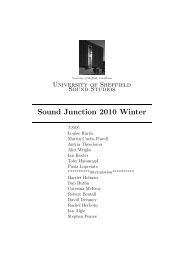Compositional Methods in Electroacoustic Music - Adrian Moore ...
Compositional Methods in Electroacoustic Music - Adrian Moore ...
Compositional Methods in Electroacoustic Music - Adrian Moore ...
You also want an ePaper? Increase the reach of your titles
YUMPU automatically turns print PDFs into web optimized ePapers that Google loves.
compose for listeners, not for analysts and musicologists, and to ga<strong>in</strong> access to this music, listeners need only<br />
to be human (with all the baggage this implies) and to be prepared to listen (surely, even analysts and musicologists<br />
are listeners first?).<br />
We are organic be<strong>in</strong>gs <strong>in</strong>habit<strong>in</strong>g an organic world, a world constantly <strong>in</strong> flux; whatever the speed of our assimilation<br />
of technologies that permit the deconstruction of that world <strong>in</strong>to zeroes and ones, our organs of<br />
perception and the cerebral mach<strong>in</strong>ery we employ to <strong>in</strong>terpret what we perceive are also organic. Why, then,<br />
should we expect our creations to be entirely ‘rational’ and to exhibit stable, repeatable, easily quantifiable<br />
components? Concepts, schemata and pre-compositional strategies may contribute to our creative endeavours,<br />
but their detection should not be the ultimate measure of musical success; the f<strong>in</strong>al arbiters here are our perception<br />
and our ability to relate what we hear to what we understand ourselves to be.<br />
<strong>Music</strong> is both concrete and ephemeral, and acousmatic music accentuates this dichotomy. On holiday (or anywhere<br />
else), we use cameras (and record<strong>in</strong>g equipment!) to try to capture the unique, fleet<strong>in</strong>g moment, the<br />
ephemeral experience of be<strong>in</strong>g ‘elsewhere.’ For me, composition (and the teach<strong>in</strong>g of composition) is the process<br />
of enabl<strong>in</strong>g such sonic snapshots to evolve <strong>in</strong>to larger musical expressions of human experience - a process<br />
that seems not only fitt<strong>in</strong>gly natural and organic, but also gives us someth<strong>in</strong>g to celebrate. For, like a holiday,<br />
life is fleet<strong>in</strong>g enough.<br />
Paper 21 - Composers Talk<strong>in</strong>g<br />
15:30<br />
Emmerson, Simon<br />
<strong>Music</strong>, Technology and Innovation Research Centre, De Montfort University.<br />
In 1991 I embarked on an unf<strong>in</strong>ished project to write an article (perhaps a book) on how electroacoustic music<br />
was really composed. One theme was to try to understand better those practices which claimed (post<br />
Pierre Schaeffer) no preconceived ‘methods’ <strong>in</strong>dependent of the material sound’s quality. These adopted an<br />
entirely empirical approach - ‘what works for the ear is right’. I sensed at that time (and still do) that this<br />
veils from us a range of approaches and methods to an art of recorded sound. Such questions as - Does it<br />
matter if you record the sound and hence are more likely to know its source/cause? How do you describe and<br />
classify your sound library? And anyway what is ‘right’? And many more... In fact I had been <strong>in</strong>terview<strong>in</strong>g<br />
composers s<strong>in</strong>ce the 1970s but not <strong>in</strong> detail about work<strong>in</strong>g methods. In December 1991 I thus <strong>in</strong>vited myself<br />
to the universities of Birm<strong>in</strong>gham and East Anglia to talk to their studio directors and composers (postgraduate<br />
students). In the summer of 2012 I discovered the tapes and digitized them - <strong>in</strong>terviews (previously<br />
unpublished <strong>in</strong> any form) with Jonty Harrison, Denis Smalley, Andrew Lewis and a group of Birm<strong>in</strong>gham students<br />
en masse. This paper seeks to unravel some of the ways composers talk about their work<strong>in</strong>g methods -<br />
maybe differently alone than <strong>in</strong> a group. And this was 1991, transitional times from analogue to digital - no<br />
mass storage or plug-<strong>in</strong>s, just some off-board digital process<strong>in</strong>g and limited real time edit<strong>in</strong>g and mix<strong>in</strong>g. How<br />
has this shift changed the discourse?<br />
Keynote - Paper 22 - ‘Lexicon’ beh<strong>in</strong>d the curta<strong>in</strong>.<br />
16:00<br />
Lewis, Andrew<br />
University of Bangor<br />
A detailed contextualisation and presentation of tonight’s work.<br />
4.5 Concert 6<br />
19:00<br />
Three Cities<br />
Stollery, Peter<br />
University of Aberdeen<br />
23



